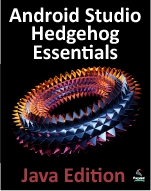Android Studio Development Essentials - Java Edition
From Techotopia
| Table of Contents | Next | |
| Introduction |
- Introduction
- Android Studio Installation and Setup
- Creating an Example Java Android App in Android Studio
- Creating an Android Virtual Device (AVD) in Android Studio
- Using and Configuring the Android Studio AVD Emulator
- A Tour of the Android Studio User Interface
- Testing Android Studio Apps on a Physical Android Device
- The Basics of the Android Studio Code Editor
- Modern Android App Architecture with Jetpack
- An Android Jetpack ViewModel Tutorial
- An Android Jetpack LiveData Tutorial
- An Overview of Android Jetpack Data Binding
- An Android Jetpack Data Binding Tutorial
- Working with Android Jetpack Lifecycle-Aware Components
- An Android Jetpack Lifecycle Tutorial
- An Overview of the Android Jetpack Navigation Architecture Component
- An Android Navigation Component Tutorial
- The Android Room Persistence Library
- An Android TableLayout and TableRow Tutorial
- An Android Room Database and Repository Tutorial
- An Android Biometric Authentication Tutorial
- Creating, Testing and Uploading an Android App Bundle
| Table of Contents | Next | |
| Introduction |





